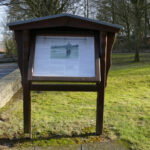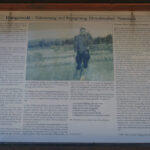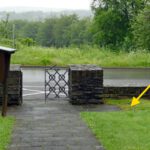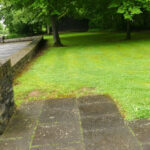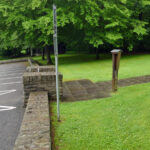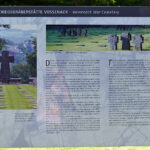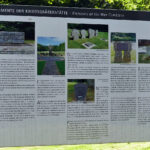“Modern culture of remembrance” in the District of Düren: The removal of the information board on Julius Erasmus from the Vossenack military cemetery in 2021 (Published on 03/10/2021, latest update on 21/06/2022)
Until recently, there was a board directly to the left of the entrance to the military cemetery in Vossenack which provided information about the cemetery as well as – in the form of the popularly spread legend – about the person and activities of Julius Erasmus. The former location of the board can be seen well, for instance, in a video by Youtube channel “Outdoor Aixplorer” from 12/05/2019 from min. 5:50 onwards (German language, accessible at www.youtube.com/watch?v=dnciUWDhwhI). In June 2021, this board had suddenly disappeared. Apparently this had not been noticed locally, at least none of the persons contacted insofar could provide any information. Since it seems to have become a remarkable tradition in the District of Düren that memorials related to the Second World War simply disappear almost overnight, quietly and silently, I tried to find out more about the circumstances surrounding the removal of the Erasmus information board.
1. Inquiry to Landesverband NRW of Volksbund Deutsche Kriegsgräberfürsorge e. V. (German War Graves Commission)
Thus, at the beginning of July 2021 I contacted the Managing Director of the State Association (“Landesverband”) of Volksbund Deutsche Kriegsgräberfürsorge e.V. in Essen, competent for the State of Northrhine-Westfalia (hereinafter “Volksbund NRW”), Stefan Schmidt, and asked him if he knew anything about the removal of the board.
In response to my inquiry, Mr Schmidt stated (translation from German):
“As an individual involved in the ‘Moratorium Hürtgenwald’ informs me, the removal of the old information board was decided upon some time ago – and in connection with the elaboration of the new information boards, which have since been placed a little higher up. With the creation of this board, the board at the entrance has been deemed superfluous.”
Mr Schmidt did not want to answer the additional question who had decided this when and who considered the board “superfluous” and referred me “to the owner of the war gravesite Vossenack, the District of Düren” (translation from German).
2. Inquiry to the Municipality of Hürtgenwald
In response to my inquiry at the beginning of July 2021, the Municipality of Hürtgenwald once again adopted its traditional attitude of refusal. An informal inquiry to Mayor Claßen about the whereabouts of the board was not answered. On the written request sent to the Municipality thereupon with five questions on the whereabouts of the board – which were likewise put to the District of Düren (see section 3. below) – they bluntly referred to the District of Düren which is responsible for the Vossenack military cemetery, without going into any substance.
Even the following explicit request for a written decision, usually a mere matter of course, was ignored.
In the court proceedings that became necessary as a result, a written decision was then issued in December 2021 after all. However, it has not been received to date, presumably due to incomplete addressing. The Municipality was also unable to send a copy of the original, but only an excerpt from its respective administrative file.
Accordingly, the Municipality of Hürtgenwald stated in its decision that it had no information on the five questions asked and referred to the District of Düren.
3. Inquiry to the District of Düren
At the beginning of July 2021, I asked the District Administrator of the Düren District the following questions about the removal of the information board on Julius Erasmus:
1. Who ordered the removal of the information board?
2. When did the removal take place?
3. What is the reason for the removal?
4. Who decided to remove the information board, when did this take place and (if applicable) what was the result of the vote?
5. When was the public informed about the removal? If not: Why not?
In his response of 16/07/2021, District Administrator Spelthahn first remarked (translation from German):
“First of all, I would like to clarify that the board you refer to is not primarily a ‘commemorative board’ for Julius Erasmus, but rather a general information board about the Vossenack war cemetery. Respectively, it was titled ‘Hürtgenwald – Remembrance and Encounter: Vossenack Cemetery of Honor’. The impression that this was a commemorative board for Julius Erasmus could be caused primarily because a large-format photograph of the former cemetery warden was depicted on it.
The text on the board dates from 2005 and was the only on-site source of information about the war gravesite for the following 10 years. In June 2015, six new information boards were erected there, thanks to the work of a history course of the neighboring Franziskus-Gymnasium. When these boards were erected, there was already agreement between the District of Düren and Volksbund NRW at the time that the board erected ten years earlier in the entrance area should be removed, because the information mentioned there had also found its way into the six new boards to a large extent, which also described the war gravesite with its various elements in even greater detail. Unfortunately, the planned removal of the entrance board was afterwards forgotten, but was then carried out a few weeks ago.”
The five questions posed to the Düren District were answered as follows (translation from German):
„Question 1: Who ordered the removal of the information board?
The removal was executed by the District of Düren in consultation with the office of Volksbund NRW.
Question 2: When did the removal take place?
The removal took place about six weeks ago.
Question 3: What is the reason for the removal?
The old information board was replaced by six new ones.
Question 4: Who decided on the removal of the information board, when did this take place and (if applicable) what was the result of the vote?
The removal was not based on a formal decision.
Question 5: When was the public informed about the removal? If not: Why not?
No information about the removal has been provided; there was neither an obligation nor a necessity to do so.“
When asked about the exact date of the removal of the board, District Administrator Spelthahn stated that he did not know it (anymore) (!) (translation from German):
“the exact date of the removal of the board is not known (anymore). It was neither recorded by the cemetery warden nor by the District administration of Düren. Unfortunately, a more precise information than ‘approx. 6 weeks ago’ (calculated from my letter of 16/07/21) is therefore not possible.“
4. Evaluation
The only thing that seems to be certain at the moment is that the removal of the information board was apparently carried out by the District of Düren at the end of May/beginning of June 2021. Whether Volksbund NRW confirms the statements made by the District of Düren remains to be seen.
a) The District of Düren and Volksbund NRW refuse to provide clarification
The handling of the issue by the District of Düren and by Volksbund NRW can only be described as bizarre. Instead of a transparent and open explanation of the removal of the Erasmus information board, the incident seems to be unpleasant to both sides, so that trying to cover it up as far as possible appears to be the preferred choice.
First of all, it is interesting to note the differences in the statements of the Managing Director of Volksbund NRW and those of the District of Düren about the reason for the removal of the board. While the Managing Director refers to (alleged) statements by a third party about a (supposed) “decision” thus giving the impression of not knowing himself the circumstances of the removal, the District of Düren indicates that it was agreed with Volksbund NRW. If the latter is true, this will usually hardly be unknown to the Managing Director of Volksbund NRW.
On the other hand, also the statements made by the District of Düren are surprising. Already the wordy explanations why this incident does not relate to a “commemorative board to Julius Erasmus” and why, however, this impression could arise, are peculiar. Why this is considered important, although the term “commemorative board” was not used anywhere – at least by me –, is unclear.
b) Remember 2005: District of Düren and Volksbund NRW erect a “legend board” for Julius Erasmus
In this context, it is worthwhile looking back to the year 2005, when the memorial stone for Julius Erasmus was inaugurated together with the now removed information board on 21/05/2005 during a public ceremony. At that time the stone was erected on the initiative of the District of Düren and Volksbund NRW, District Administrator Spelthahn had taken over the “patronage” for the inauguration ceremony (see the article “The fallen did not allow him to rest – Memorial board for Julius Erasmus, the ‘Undertaker of Vossenack’, unveiled at the cemetery of honor” [Die Gefallenen ließen ihm keine Ruhe – Auf Ehrenfriedhof Gedenktafel für Julius Erasmus, den ‚Totengräber von Vossenack‘, enthüllt“] in the Düren local edition of Aachener Nachrichten of 24/05/2005). Interestingly, the information board on Julius Erasmus was called a “legend board” at that time. For the same District Administrator who then honored Julius Erasmus with a “legend board”, it is now important to emphasize that it was not even a “commemorative board”.
Remarkable are also the statements made by District Administrator Spelthahn at the inauguration of the plaque on 21/05/2005. According to the aforementioned newspaper report he said there, amongst others (translation from German, emphasis by the author):
“’Today we thank Julius Erasmus for his life’s work in a very concrete way,’ said District Administrator Wolfgang Spelthahn at the unveiling of the memorial stone, ‘but today we also remember all the victims of this cruel war.’ This commemoration, the District Administrator continued, was not about guilt. It was much more about reminding and remembering. ‘There is a very high willingness of people today to settle conflicts with violence.’ In the Hürtgen Forest alone, 70,000 soldiers had met their deaths during the Second World War. ‘These were all victims sent to a senseless death in the fulfillment of duty,’ Spelthahn said. The eyewitnesses of this terrible war were becoming fewer and fewer. That made memorials all the more important nowadays. ‘We need memorial stones like this one so that the memory does not die, so that a war never again emanates from this soil.’ That is why the commitment of Julius Erasmus could not be valued highly enough, said Spelthahn, who had taken over the patronage for the memorial event on Saturday. ‘He recovered the dead, if possible recorded their data and thus returned their dignity to them.’”
It is not difficult to recognize certain fundamental contradictions between the statements made by the District Administrator in the year 2005 and those made in his letter on the removal of the information board from 16/07/2021. Is an information board such as the one on Julius Erasmus that was now removed no longer important to ensure that – in the words of District Administrator Spelthahn in 2005 – “memory does not die, so that a war never again emanates from this soil”? Apparently not.
c) Has the Erasmus information board become “superfluous”?
Of course, the District of Düren, just like Volksbund NRW, tries to give the impression that the information board is no longer needed (“superfluous”), “because the information mentioned there had also found its way into the six new boards to a large extent”. So which contents of the information board on the person of Julius Erasmus and his activities can be found on the six new boards? The unsurprising result is: Almost none.
On the third board, entitled “Vossenack War Cemetery”, Julius Erasmus is mentioned as follows:
“Julius Erasmus (1895-1971), an Aachen-born former engineering [sic!] captain of the German Wehrmacht was a very well-known individual of the time. He and his helpers had recovered a total of 1,557 bodies since the end of 1945.”
This is the only information that can be found on the person and activities of Erasmus on these six boards; the reasons why Erasmus was “very well-known” are not explained. The origin of these few pieces of information provided is unknown; however, most of them are likely to be false according to the actual research here.
On the fifth board (title: “Elements of the War Cemetery”) the death of and the memorial stone to Julius Erasmus are briefly mentioned, again in a meaningless way:
“In 2005, the Commission erected a memorial stone to commemorate the ‘Gravedigger of Vossenack’, Julius Erasmus. (…) Julius Erasmus himself is not buried at the war cemetery.”
d) Conclusion
It seems that the commemoration of the “Undertaker of Vossenack” is now a thorn in the side of both the District of Düren and Volksbund Deutsche Kriegsgräberfürsorge, so that they strive for the elimination of the memory of Julius Erasmus and his activities. Apparently, it is tried to move towards that goal in a first step by replacing on the military cemetery in Vossenack the original elaborate (although often incorrect) information board with strongly reduced, very vague and meaningless information about his person and his activities, which the reader of the corresponding boards usually reads over and which does not give him any impulse to think further or to ask questions.
It would not be surprising if, in a future step, for instance in the course of a “contemporary revision” of the boards, these vague statements would also be removed as “superfluous”. After all, they are so abstract and empty of content that the reader can make little sense of them anyway and will not miss them. As a part of this development, a removal of the memorial stone for Julius Erasmus might then be propagated sooner or later – provided it does not simply disappear overnight, in accordance with recent practice in the Düren District.
New findings on the removal of the information board will be reported here.
(Head picture: Tombstone light in the ruin of a Siegfried Line pillbox at Ochsenkopf hill, June 2021)
Further articles on the topic “‘Modern culture of remembrance’ in the District of Düren”:
- The removal of the information board on Julius Erasmus from the Vossenack military cemetery in 2021 (03/10/2021)
- Volksbund Deutsche Kriegsgräberfürsorge NRW on the removal of the information board on Julius Erasmus from the Vossenack military cemetery in 2021 (17/06/2022)
- News on the removal of the information board on Julius Erasmus from the Vossenack military cemetery in 2021 (23/08/2022)
- The “representative for the care of the war grave sites Vossenack and Hürtgen as places of a democratic culture of remembrance and commemoration” (“Beauftragter für die Betreuung der Kriegsgräberstätten Vossenack und Hürtgen als Orte einer demokratischen Erinnerungs- und Gedenkkultur”) (16/11/2022)
- The ban on laying flowers and candles at the military cemeteries in Hürtgen and Vossenack (12/02/2023)
- Administrative Court Aachen denies grant of a preliminary order against the District of Düren “flower ban”, appeal to the Higher Administrative Court (23/03/2023)
- Laying of wreaths by the Administrator of the District of Düren at the Military Cemeteries in Hürtgen and Vossenack on Remembrance Day 2022 – or: Quod licet iovi, non licet bovi? (21/04/2023)
- District of Düren denies “flower ban” on Military Cemeteries in Hürtgen Forest to press and media (13/05/2023)
- “Flower ban” of the District of Düren on the Military Cemeteries in Hürtgen Forest: Higher Administrative Court of the State of North Rhine-Westphalia rejects the appeal against the denial of urgent legal protection (03/07/2023)
- Administration out of control – District now also bans photos of the fallen in uniform at Military Cemeteries in Hürtgen Forest (18/08/2023)
- The “permanent exhibition” on the Hürtgen war cemetery (20/12/2023)
- The removal of the memorial stone for Julius Erasmus by the District in September 2022 (06/02/2024)
- The distortion of remembrance on the national Remembrance Day (“Volkstrauertag”) (21/04/2024)
- The “Dance Theater” over the graves of the war dead at the military cemetery in Vossenack on the occasion of Remembrance Day (“Volkstrauertag”) 2023 (19/08/2024)
- The statement of the President of Volksbund Deutsche Kriegsgräberfürsorge e. V. on the “Dance Theater” at the military cemetery in Vossenack on the occasion of Remembrance Day 2023 – a “fact check” (13/11/2024)
- Information from the District administration on “incidents with a right-wing extremist background” at the military cemeteries in Hürtgen and Vossenack and on “violations” of the cemetery rules (13/03/2025)
- The “flower ban” by the District of Düren on the German military cemeteries in Hürtgen Forest before the State Constitutional Court of Northrhine-Westfalia (30/04/2025)
- “Flower ban”, “dance theater” and the Geneva Conventions (22/05/2025)
- “Dance Theater” over the graves of the war dead at the military cemetery in Vossenack is not a criminal offense (16/09/2025)
If you wish to support my work on Julius Erasmus, you can do so here. Many thanks!


